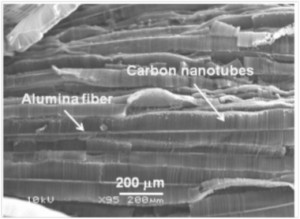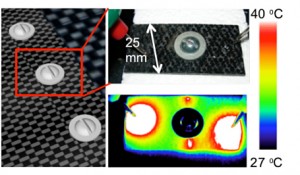Preventing Catastrophic Failures: Nano-engineered Multi-physics Materials for Structural Applications
- Category: MEMS & BioMEMS, Nanotechnology
- Tags: brian wardle
Catastrophic structural failures cause many physical and personal losses, with prevention estimated at billions of dollars in savings each year. Non-destructive evaluation (NDE) techniques have been pursued and employed for damage detection of such structures to detect cracks and other damage at pre-critical levels for remediation[1],[2]. Here, a novel multi-physics approach is reported that addresses drawbacks in existing techniques by taking advantage of the effects that damage, such as a crack, has on the electric and thermal transport in a material containing a CNT network distributed in the bulk material. When a potential is applied to a nano-engineered structure (see Figure 1), electric field lines concentrate in the vicinity of cracks as electrons flow around damage, causing field concentrations and “hot spots” via Joule heating, an effect which is amplified because the heat flow is also impeded in areas of damage (e.g., across a crack face). These changes of temperature can be localized through a conventional infrared thermal camera. Low power operation (a 9V standard battery is exemplary, providing a 15C rise at 1 Watt as in Figure 2) and high spatial resolution are demonstrated that are beyond state-of-the-art levels in non-destructive evaluation. Multiple applications have been identified using this technique such as crack detection in composite components that are joined by metallic fasteners, structures having internal nonvisible damage due to impact, and in situ progressive damage monitoring during a tensile strength test. The thermal nano-engineered NDE technique demonstrated here can provide a new and effective inspection route for monitoring the next generations of safer infrastructure[3][4][5]. Further expansion on this work has yielded significant technologies in ice protection systems (IPS) for vehicle structures such as unmanned aerial systems (UAS)[6] with application to infrastructure needs such as wind turbines and bridges.
- Figure 1: Nano-engineered material and its components. Aligned carbon nanotubes grown directly on the surface of an alumina fiber cloth.
- Figure 2: Damage inspection of a model bolt-hole composite joint. Voltage (0.16 and 12.3 V) was applied directly through hand-held probes to induce heating.
- D. Barber, S. Wicks, A. Raghavan, C.T. Dunn, S. S. Kessler, and B. L. Wardle, “Health monitoring of aligned carbon nanotube (CNT) enhanced composites,” presented at 2009 SAMPE Fall Technical Conference, Wichita, KS, 2009. [↩]
- S. Wicks, A. Raghavan, R. Guzmán de Villoria, S. S. Kessler, and B. L. Wardle, “Tomographic electrical resistance-based damage sensing in nano-engineered composite structures,” presented at 51st AIAA Structures, Structural Dynamics, and Materials Conference, Orlando, FL, 2010. [↩]
- R. Guzman de Villoria, N. Yamamoto, A. Miravete, and B. L. Wardle, “Multi-physics damage sensing in nano-engineered structural Composites,” Nanotechnology, vol. 22, pp. 185502-185508, 2011. [↩]
- R. Guzmán de Villoria, A. Miravete, N. Yamamoto, and B. L. Wardle, “Enhanced thermographic damage detection enabled by multifunctional nano-engineered composite laminates,” presented at 52nd AIAA Structures, Structural Dynamics, and Materials Conference, Denver, CO, 2011. [↩]
- N. Yamamoto, R. Guzmán deVilloria, and B. L. Wardle, “Electrical and Thermal Property Enhancement of Fiber-Reinforced Polymer Laminate Composites through Controlled Implementation of Multi-Walled Carbon Nanotubes,” Composites Science and Technology, 72 (2012) pp. 2009–2015. [↩]
- S. Buschhorn, N. Lachmann, G. Thomas, J. Gavin, S. S. Kessler, and B. L. Wardle, “Electrothermal Icing Protection of Aerosurfaces Using Conductive Nanocomposites,” AIAA-2013-1514331, 54th AIAA Structures, Structural Dynamics, and Materials (SDM) Conference, Boston, MA, April 8-11, 2013. [↩]

